Delivered Fresh from the Southern Hemisphere A Trio of Australia’s Finest Extra Virgin Olive Oils Ready to Enhance Autumnal Meals and Celebrations
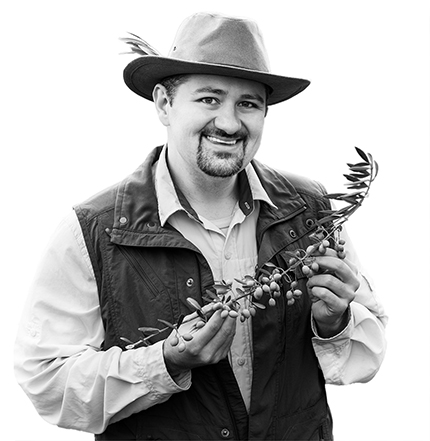
- Meticulously chosen by your Olive Oil Hunter, working hand in hand with the country’s leading artisanal producers.
- Rich in the polyphenols that impart extra virgin olive oil’s unique depth of flavor and hold the secret to so many of its health benefits.
- Rushed to the US by jet to maximize freshness and certified to be 100 percent extra virgin olive oil by an independent lab.
Come with me to the magical land Down Under! I make the journey to Australia at this time every year to hunt for the freshest olive oil for Club members. Oz has a dynamic New World olive culture with the opposite harvest season from the Mediterranean. Though I’ve been visiting for more than 20 years, I remain fascinated by the sights, sounds, and, of course, the aromas and tastes I encounter. As you savor each of the selections in this quarter’s trio, know that my Merry Band of Tasters and I captured the essence of Oz in these three exquisite blends.
First Stop: Melbourne
Home base for my visits is the enchanting capital of Victoria, the southeastern state with beautiful topographic variety—picturesque coastlines, alpine landscapes, and sandy deserts. The city of Melbourne is a vibrant melting pot of cultures, with impressive Italian and Asian contingents, not to mention the largest Greek community outside of Greece. Reconnecting with our producers who are also dear friends is especially fun, because we often do so around convivial tables at amazing restaurants—meals that inspired the recipes in this Pressing Report, so you, too, can savor the flavors of this country.
John and Marjan Symington of Oasis joined me and my Merry Band of Tasters as we immersed ourselves in the hustle and bustle of the Queen Victoria Market, with its wealth of vegetable and fruit merchants and cheese and fishmongers. At a stand with Australian olives—but no Australian olive oil—Marjan, president of the Goulburn Strathbogie Olive Oil Association, immediately struck up a conversation with the proprietor, suggesting he add it to his offerings ASAP!
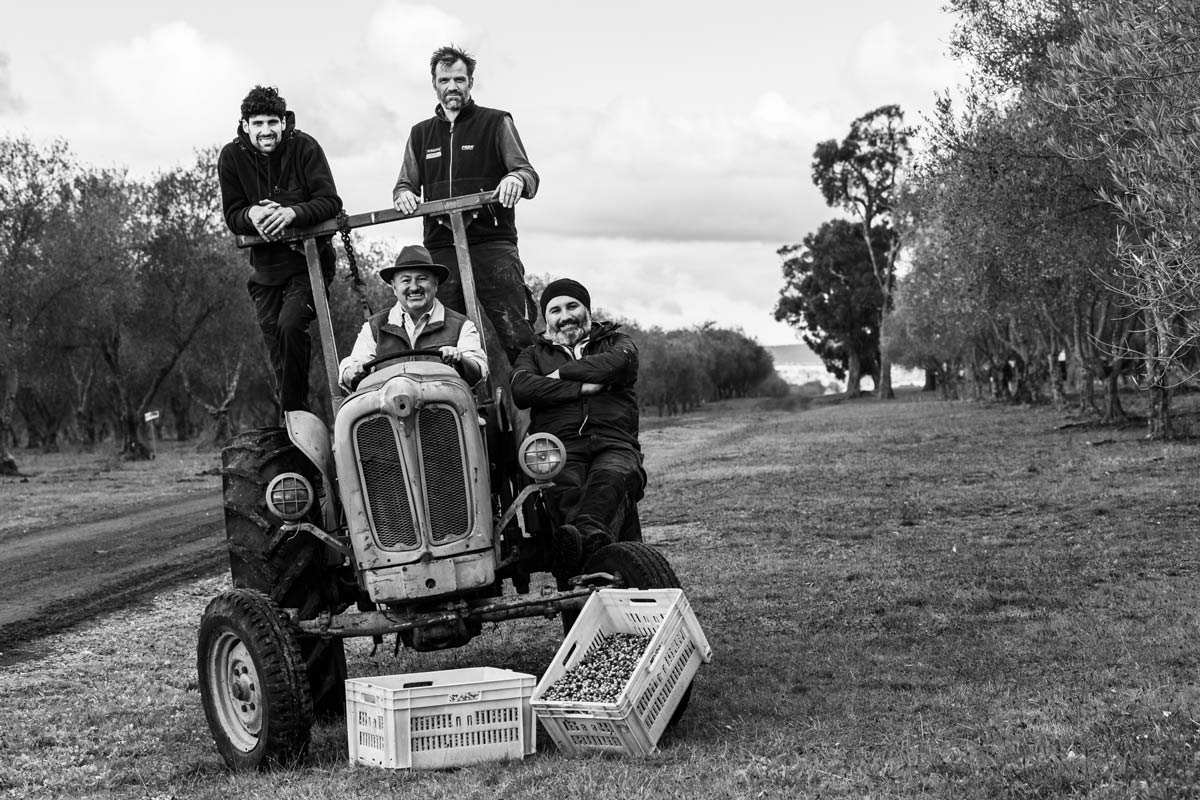
With Mick Labbozzetta, the esteemed estate manager at Kyneton, we returned to Brunetti’s on Lygon Street, my favorite “Little Italy” neighborhood on the planet, for delicious pastries and rich coffee. When we passed a shop dedicated to cappuccino makers, we remarked at how the coffee culture in Australia has exploded—just a decade or so ago, it was barely on the radar (by contrast, sweets, as you’ll see in the dessert section of this report’s recipes, have always been top of mind!).
With Melissa Wong, my trusted Aussie advisor, food authority, and Michelin-star restauranteur, we discovered our new favorite Asian restaurant, Old Beijing, and ate our fill of Peking duck, stir fries, soup dumplings, and vibrant Chinese greens. We also indulged in local seafood at the Stokehouse in the St. Kilda Beach section of Melbourne, near Melissa’s home, a meal that starred crayfish with shellfish bisque sauce, yellowfin tuna with tomato dressing, and perfectly grilled King George whiting.
Shortages Span the Globe
While the main event of every visit to Oz is the grand tasting Melissa organizes for us to choose oils and create blends for you, my discerning Club member, that was just the beginning of what turned out to be a seven-day marathon of tastings to perfect our selections.
When I’m in Australia, I always want to check in with Leandro Ravetti, one of the world’s most respected olive authorities, to get his insights into the current season and, most important, his input on the olive oils I’m considering. Longtime friend of the club, Leandro is a master miller who champions the highest standards. He confirmed that the worldwide olive shortage had made its way around the globe and that production at many Aussie olive oil farms was down about 45 percent this season. As we saw in Europe, this has led some producers to leave their fruit to ripen until the olives are black and full of low-quality oil, in contrast to our collaborators, who harvest during the magic window—just the right moment, when the fruit is still green and at the pinnacle of flavor and health benefits. (Mass-market producers also rely on heat in the extraction process for a higher yet inferior-tasting yield.)

“As a counterpoint to Europe, which has experienced three dry years in a row, we had three wet years in a row,” Leandro explained. While he expects conditions to soon normalize, he’s always thinking ahead to avoid future problems. An ongoing concern centers on frost, which can harm the tiny buds as they start to form. “In countries in the Southern Hemisphere, where winters are not normally very wet, like Australia, the frost risk in early spring is high,” he said.
In some areas, there can be frost at ground level while the air just above, at five to fifteen meters, is warmer. Leandro’s ingenious solution is to use special fans that draw in the warmer air to raise the ground temperature and protect the buds that will become olives. I admire the way Leandro shares his expertise with fellow producers and the deep camaraderie they enjoy—there’s no sense of one-up-manship in this country. I also value how generous Leandro is with his time when I visit, despite his having one of the most demanding schedules I’ve ever seen.
Our Olive Oil Odyssey
The magic window for harvesting was somewhat unusual this year, and certain varieties were staying green on the trees for weeks. This led to numerous tasting rounds—challenging and fun at the same time. To visit the farms we planned to work with—Oasis, Nullamunjie, and Kyneton—we embarked on a wide, 700-mile loop around Melbourne. Being right at the mills is like being a kid in a candy store, indulging in all the sweets with abandon! It’s always pure joy to spend time with the millers, sample each farm’s distinctive olive oils, and work together to perfect our blends. I invite you to taste the fruits of our labor and to catch up with our chosen producers in the pages that follow.
Happy drizzling!

T. J. Robinson
The Olive Oil Hunter®
This Quarter’s First Selection
- Producer: Oasis Olives, Kialla, Goulburn Valley, Victoria, Australia 2024
- Olive Varieties: Picual, Coratina
- Flavor Profile: Mild
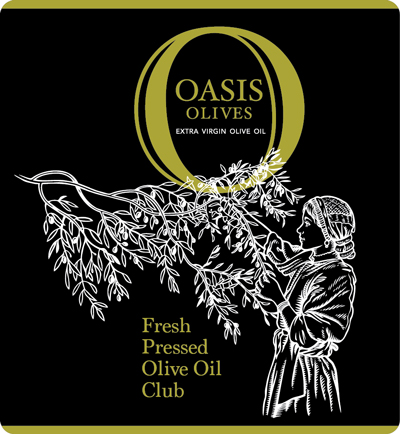
We’re all connected to our smartphones, but during my time with John and Marjan Symington, John could barely put his down—his cell rarely stopped ringing with people looking for olive oil from his glorious farms. “Because there’s so little olive oil to go around this season, folks like us that did have olives to produce oil are very busy,”
John said candidly. “We’ve got quite a good crop in Kialla—it’s been a good season for us.”
Oasis Olives, the venture he started as a retirement passion project, seems to be keeping John busier than he was during his successful career in information technology. To say that he and Marjan have come a long way in the 14 years since they bought their first groves—on a ramshackle farm with much neglected trees—is an understatement. They recently replanted 40 hectares from the latest farm they acquired, a parcel adjacent to theirs, because a lot of those trees were so neglected. My Merry Band of Tasters and I are already looking forward to the fruit the new trees will bear.
Why is Oasis a perennial award winner? “The biggest factor that can impact the flavor profiles of olive oils is the climate,” John said. “Kialla is an environment where the trees have a very easy life in general, whereas if you go more toward South Australia, it’s a much drier climate. In other areas, where it’s very wet, the oils tend to be more washed out. This year Mother Nature gave us reasonably mild temperatures right through the growing season. We had a dry summer and dry autumn too.” Credit also goes to John and Marjan’s tenacity and their determination to produce olive oils that discerning palates, including our Club members, will love. That their kids are getting more involved in the operation brings the Symingtons a double dose of bliss.

While in Kialla, I had a chance to catch up with Scott Sanders, an international olive oil consultant who joined Oasis in 2016 and quickly became the farm manager. Scott grew up on his own family’s farm in northwest New South Wales and developed a deep love of the land. At the young age of 20, he became fascinated with the world of olive oil and “traveled to Italy and Spain to learn the art of olive oil making,” he recounted. Scott and the Symingtons share a commitment to sustainability—sheep are used to control weeds, olive pomace (what’s left of the olive flesh after milling) is a natural fertilizer for the land, and even the olive pits get a second life as a fuel source.
Because Scott felt that some varietals had it a little too easy this year, he decided to cut the irrigation to the Picual and the Coratina trees destined to be contenders for the Club in order to stress them and, in turn, bump up the polyphenols along with the flavor and aroma. “Stressing the trees also facilitates harvesting. If the trees are too ‘happy,’ they don’t want to let the fruit go,” he explained.
“Scott’s breadth of experience is incredible—he’s worked at olive mills from Australia to Spain to California,” John said. “Scott has seen a lot of different environments, a lot of different olives, so there’s not much that comes up that’s new to him.” He’s also been imparting his wisdom to Antonio and Domenico, the Italian millers who, for the past three harvests, have flown in from Puglia to run the mill. And what an olive oil this talented Oasis team has made exclusively for the Club. For the last few years, I’ve been waiting for an oil that could match the perfect—and elusive— Picual that John crafted for us many years ago. Our mild selection is early-harvest Picual at its best. Enhanced with a touch of Coratina, it hits the mark.
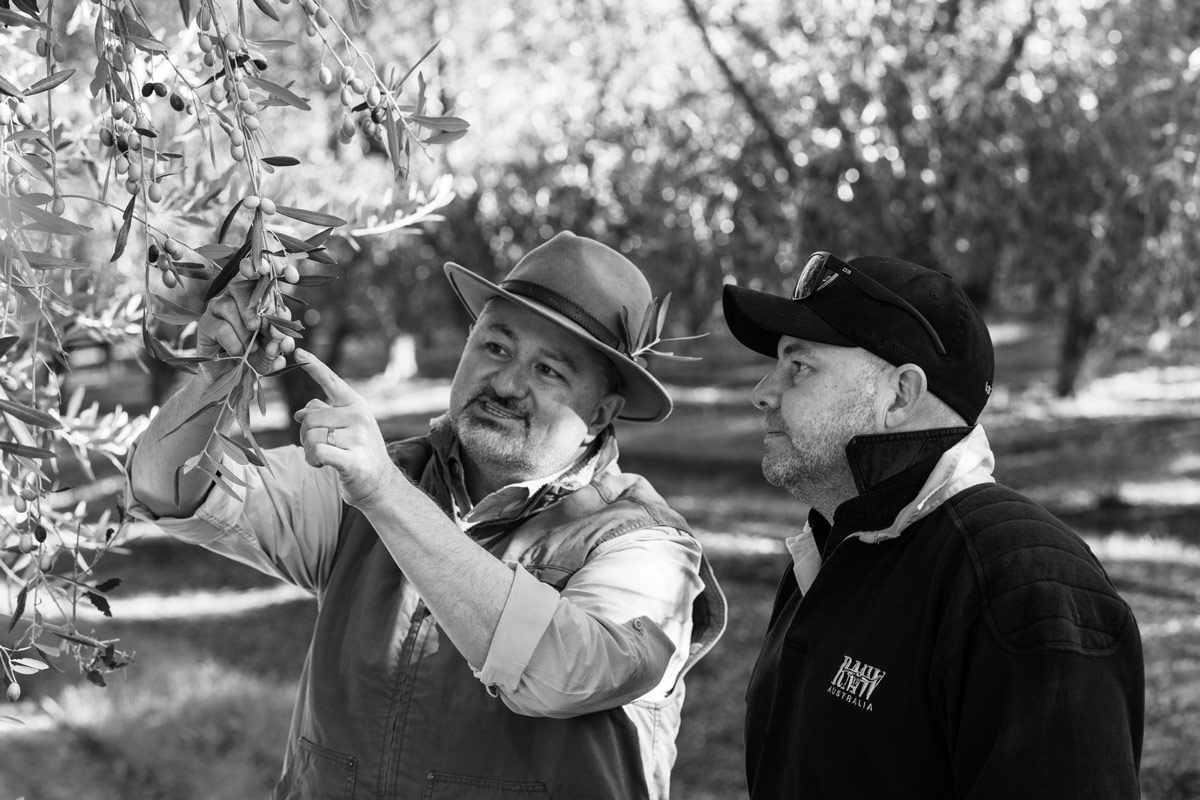
Impressions and Recommended Food Pairings
This is a highly aromatic blend of Picual and Coratina with amazing flair. The distinctive aromas of grass, tomato leaf, and banana are layered with hints of pear, apple, almond, oregano, sweet basil, baby lettuces, white pepper, and wheatgrass. On the palate, we noted the sweetness of dried tropical fruits and Sungold cherry tomatoes, along with lemon, hazelnut, basil, mixed spring lettuces, and the bitterness and spiciness of baby arugula. Luxurious in the mouth, it has a long, spicy finish.
You’ll love it for mild vinaigrettes, salads with fruits, tomato bruschetta, egg dishes, mild cheeses like brie and goat, yogurt and granola breakfast bowls, nutty banana bread* and muffins, chicken and leek pie, mild fin fish, crispy potatoes, pastas with fresh tomato-based sauces, glazed carrots, squash and pumpkin dishes, smoothies, and tiramisù.
*See the recipe section for bolded dishes.
This Quarter’s Second Selection
- Producer: Nullamunjie Blend, Tongio, Victoria, Australia 2024
- Olive Varieties: Correggiola, Coratina, Leccino, Pendolino
- Flavor Profile: Medium

The effervescent and unstoppable Annie Paterson has owned, developed, and run the Nullamunjie farm, with its olive groves, vegetable garden, seasonal café, and sheep, since 1998. Born and reared in the Australian ranch country, as a young woman Annie traveled to Greece, where she was mesmerized by the silvery-leafed olive trees she glimpsed through the tour bus window. She dreamt of growing olives in Australia, with its similar climate. Decades later, after she and her husband had raised their four children, Annie acquired land at the foot of Mount Stalwell, in East Gippsland, with the Tambo River running through it, and made her dream a reality.
She is one of the original wave of entrepreneurs who put ultra-premium Aussie olive oil on the map—and, as the Down Under olive oil scene changes, Annie, a true pioneer, remains both stalwart and flexible, maintaining impeccable standards while incorporating innovative techniques to protect her trees and the natural world around them.
To deter cockatoos and other birds from eating olives off the trees, Annie has debuted a new sound cannon, which her crew demonstrated for me with a deep “FOOM!” As we all reflected, though, Annie is such a softie that she’ll say to an individual bird, “Oh, but I like you, you can stay.”
Speaking of staying, Annie made me laugh so hard as she described a wombat that has recently decided to live down the hill from her home. The furry, dog-sized marsupial has carved out a massive burrow beneath an old olive tree—“A cave, a cave it was; I could almost walk into it without crouching down,” exclaimed Annie—with the tree’s roots hanging down “like stalactites.” No word whether Annie is going to charge him rent.
In 2023, Annie purchased the neighboring farm, historically named Tongio Station—“The big old properties in Australia used to be called stations,” she explains—to give Nullamunjie an additional 800 acres. This season, her team planted close to 1,200 baby trees. I couldn’t wait to see them.

On our way to the farm, about four hours from Melbourne, my Merry Band of Tasters and I stopped at Bruthen Bakery to pick up goodies for the team. We brought boxes of vanilla slices and meat pies, including my favorite, a succulent steak-and-pepper pie—essentially pastry-wrapped pot roast.
Upon our arrival, operations manager Riley Nivens hopped into his 4×4 to take us around the new groves as we munched on pastries. The baby trees were almost invisible against the hills behind them, so tiny, so fragile—barely the size of corn stalks. Solar panels, elegantly arranged in a nearby clearing, captured energy from the sun to run the irrigation pumps. These baby trees won’t be mature enough to produce oil for several years, so, right now, the main concern is keeping them vertical. In spite of an electric fence, deer and kangaroos bound out of the surrounding hills and flatten the infant saplings in their path. On a daily basis, Riley inspects the rows and gingerly repositions or replants any trampled trees.
“The wonder that is Riley,” Annie praised, “he saved us all.” She added, in the style of an auto-racing commentator: “He continues to impress.” Annie alluded to the curveball that Mother Nature chucked at Nullamunjie during the growing season: torrential rainfall that knocked the blossoms off the Frantoio trees, which meant no olives. Thankfully, the other varietals—Correggiola, Leccino, Coratina, Pendolino—flowered a few weeks later and benefited from the rain.
Annie’s olives are harvested and pressed together as a “farm blend,” always recognizable as Nullamunjie olive oil, even as the flavor profile takes on different nuances and dimensions from year to year. The unique terroir gives Nullamunjie its special character and soul.

Coratina comes to the forefront in this blend, providing backbone and a hint of bitterness, indicating health-promoting polyphenols, to create a beautifully harmonious and food-friendly oil. When I asked Annie (as I always do) for her latest, greatest recipe using olive oil, she said, “I still think the best way to use olive oil is to put it on a freshly grilled steak.” We concurred that, ideally, this would be a grass-fed steak, with a little extra fat for flavor, and fresh-pressed Nullamunjie oil drizzled generously over the meat as it comes off the grill. Mmmmmmm. I hope you’ll take our recommendation and also come up with your own!
Impressions and Recommended Food Pairings
The fresh aromas of green grass, Belgian endive, Tuscan kale, celery, and fennel perfume this blend of Italian varietals. There are notes of oregano, rosemary, wild mint, green apple, almond, walnut, pine nut, and lemon zest. We tasted radicchio, Swiss chard, baby spinach, walnut skin, vanilla, rosemary, the astringency of green tea and lime zest, and the persistent spiciness of black peppercorns.
It will elevate crusty breads, shaved fennel and citrus salad, cheeses, and charcuterie boards. It will enhance lamb kebabs with mixed grilled vegetables,* pot roast, roasted turkey, prawn and pork fried rice, bouillabaisse, pastas with pesto, pizza, focaccia, barley and farro, lentils, white beans and other legumes, Brussels sprouts, cabbage or cauliflower steaks, vanilla ice cream, sautéed apples, lamingtons, and other desserts with chocolate.
*See the recipe section for bolded dishes.
This Quarter’s Third Selection
- Producer: Kyneton Olive Oil, Bylands Estate, Victoria, Australia 2024
- Olive Varieties: Frantoio, Correggiola, Coratina, Leccino
- Flavor Profile: Bold
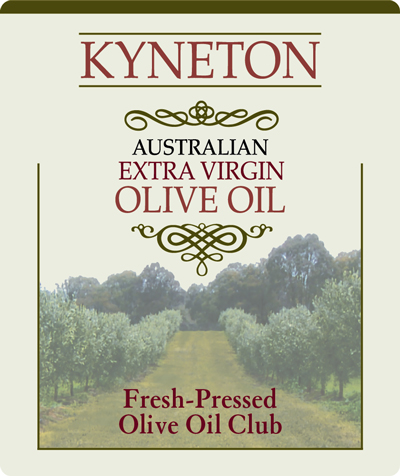
I first visited Kyneton, about an hour’s drive north of Melbourne, in 2009. It’s a beautiful place—I especially love the lake surrounded by palm trees. I remember when, the next year, their state-of-the-art Pieralisi mill was installed. Ever since, it’s been an upward trajectory, as Kyneton’s premier oils have won multiple awards in Australia and abroad. Kyneton is always poised to upgrade the mill and other equipment, but the most recent enhancements added to the beauty of the landscape: a newly built gazebo, wood-fired oven, and fire pit. My only regret was not arriving one day sooner. I was dismayed to learn I’d just missed homemade porchetta sandwiches—dang!
Food—including olive oil, of course—is one of the things estate manager Mick Labbozzetta and I have bonded over. For years, Mick, always wearing his trademark newsboy cap, has introduced me, one by one, to his favorite salumerias, formaggerias, pizzerias, and gelaterias, a reflection of Australia’s large Italian population. Naturally, we bring a bottle of fresh-pressed olive oil to drizzle everywhere we go. (I don’t consider an oil properly vetted unless I’ve paired it with a variety of foods. I urge you to do the same, dear Club member!)
Mick’s love of Italian delights comes naturally. His father was born in Calabria, Italy, and was among a large wave of Italian immigrants who arrived on the Australian continent in the mid-twentieth century. In an ode to his homeland, Papa planted about 20 olive trees on the family’s property. Born in this country and raised in Adelaide, Mick speaks fluent Italian thanks to his dad, whose birthplace Mick will be visiting this fall. Family means the world to Mick, and, though he has no intention of retiring, all his improvements at Kyneton, which include building his impressive team, are with his grandchildren in mind, to bring them into this very special world.
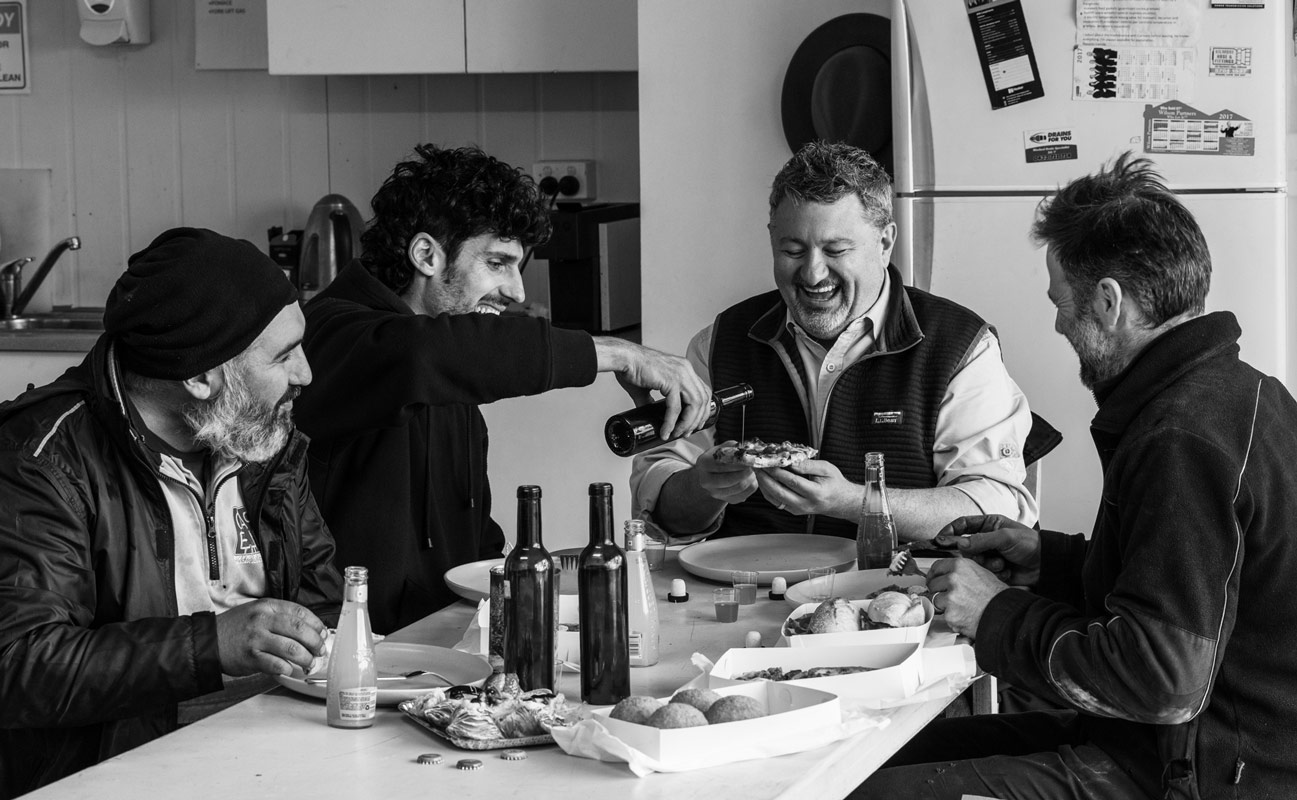
As a boy, Mick picked the olives from his dad’s trees. The olives were then pressed by a neighbor. Today, the Kyneton mill is trusted to press the olives of local farmers. Testament to Kyneton’s skills and
passion for olive cultivation, the team recently took over the management of a nearby olive grove of 14,000 trees, primarily Koroneiki and Frantoio. The owner would bring his olives for pressing, but the yield didn’t match the size of the grove—indicating that the trees needed tending. These are very small trees, Mick told me, that will undoubtedly thrive from the TLC that the Kyneton team will lavish on them—my mouth is already watering in anticipation!
Mick is quick to deflect praise for the estate’s successes to his team, headed by native Calabrian Carmelo Tramontana and the peripatetic Davide Bruno, a master miller who travels from Liguria each year to oversee the harvest. This year, they were joined for the first time by Arturo Morara, another—you guessed it—Italian. With experience working at Italian mills, Arturo explained to me that he had been looking for an opportunity to hone his talents on an Australian olive farm during the harvest, in effect doubling the amount of experience he was gaining each year. Kyneton was a natural fit. I’m convinced this intersection of New and Old World techniques and sensibilities makes Kyneton oils special. “Australian made, Italian heritage” is the company’s very apt motto. The addition of a team member did not manage to reduce anyone’s hours—20-hour days are still the norm during the harvest to create the exquisite olive oils for which the farm is known.

My Merry Band of Tasters and I had a scandalously good time perfecting the blend I’ve selected for you, primarily because we had so many great options to work with this year—small batches of different varietals harvested at different times and blended in different proportions, all fresh from the mill. Davide and his team constantly monitored the trees, identifying which olives were at their peak. Davide has a sixth sense about these drupes, and, on occasion, his intuition even overrides the lab’s ripeness analyses. After five years of collaboration, he understands what flavor and aroma profiles I want for my Club members and in my own kitchen. I can’t wait for you to taste this bold liquid gold.
Impressions and Recommended Food Pairings
A vibrant blend of Aussie-grown Italian varietals, it entices with aromas of kale, arugula, fennel, chopped culinary herbs, and hazelnut, and hints of green bell pepper, lime zest, green peppercorns, and tomato vine. We tasted fennel, artichoke, Belgian endive, dried banana, green walnut, parsley, thyme, dried chiles, the freshness of wild mint and citrus peel, and the spiciness and bitterness of watercress.
This oil will enhance aged and blue cheeses, Caesar salad, Asian mushroom salad with ginger tamari vinaigrette,* grilled steaks and chops, apricot chicken, pan-seared fish steaks with caramelized fennel, sardines, curries, Tex-Mex chili, pasta Bolognese, stuffed peppers, green beans, kale dishes, holiday stuffings, bok choy and Chinese broccoli, black beans, hearty soups and stews, carrot cake, and nut-based desserts.
*See the recipe section for bolded dishes.
Olive Oil and Health
Part I: a Primer on Oleic Acid (OA)
A large body of evidence shows that daily consumption of EVOO confers numerous health benefits, including a significantly reduced risk of cardiovascular disease (CVD).
Factors that contribute to CVD include cholesterol, inflammation, blood vessel function, insulin resistance, and high blood pressure (hypertension). The protective effects of EVOO are attributed to its bioactive components, oleic acid (OA) and more than 30 polyphenols.
In this concise review, we’ll look closely at the mechanisms by which OA works in the body to modify and improve these factors.
What is OA? Oleic acid is a monounsaturated fatty acid (MUFA) that makes up approximately 70 to 80 percent of EVOO by volume. MUFAs and PUFAs (polyunsaturated fatty acids) are the key components of liquid fats, such as vegetable oils and the fats in fish.
Lowers “bad” cholesterol and blood lipid levels: OA lowers LDL or “bad” cholesterol by increasing the amount of LDL that is removed from the blood by the liver and reducing the amount that is produced. In scientific terms, OA increases hepatic LDL receptor activity. Similarly, OA helps lower triglyceride levels by stimulating the liver to increase the breakdown and removal of the proteins that produce triglycerides.
Helps regulate blood pressure: After eating, we experience what is termed the postprandial reflex—a rise in blood triglycerides and increase in blood pressure. When OA enters cell membranes, signals are sent from the intestines to the blood vessels to release vasodilators, which relax the blood vessels, and to block the release of vasoconstrictors, which tighten the blood vessels and raise blood pressure.
Protects the blood vessel lining: Damage to the blood vessel lining (the endothelium) is a major risk factor for CVD. By stimulating the release of vasodilators, OA helps protect the endothelium. OA
also blocks signals from inflammatory proteins that are released with the postprandial reflex, reducing oxidative stress (which can lead to cell damage) and helping prevent atherosclerosis (buildup of cholesterol plaques in the arteries).
Increases insulin sensitivity: In a study of patients with obesity, OA was shown to up-regulate—increase the activity of—a gene that increases insulin sensitivity. OA also reduces insulin resistance in vascular smooth muscle cells, which make up the blood vessel walls.
Studies continue to reveal the ways in which OA exerts its multiple health-promoting effects. In 2018, the FDA determined that evidence supported a qualified health claim that the daily consumption of 20g daily of high-OA oil (EVOO or other high-oleic oil) may reduce the risk of coronary heart disease.
Stay tuned for part II, in which we’ll explore how the polyphenols in EVOO exert powerful protective effects against CVD.
References: 1. Lu Y, Zhao J, Xin Q, et al. Food Science and Human Wellness. 2024;13:529-540. 2. Pirahanchi Y, Sinawe H, Dimri M. Biochemistry, LDL Cholesterol (National Library of Medicine, 2023). 3. Zheng C, Khoo C, Furtado J, Ikekawi K, Sacks FM. Am J Clin Nutr. 2008;88(2):279-281. 4. US Food and Drug Administration. Constituent Update, November 19, 2018. https://www.fda.gov/food/cfsan-constituent-updates/fda-completes-review-qualified-health-claim-petition-oleic-acid-and-risk-coronary-heart-disease.
Kudos from Club Members

Recipes
 Apricot Chicken It’s said that the Australian version of apricot chicken, whose simple ingredients were apricot nectar, a packet of dried French onion soup, and chicken parts, became popular in the 1970s; many adults Down Under grew up on it. My version takes more of a “from-scratch” approach for richer flavor. Ingredients 1/2 cup whole wheat flour… view recipe
Apricot Chicken It’s said that the Australian version of apricot chicken, whose simple ingredients were apricot nectar, a packet of dried French onion soup, and chicken parts, became popular in the 1970s; many adults Down Under grew up on it. My version takes more of a “from-scratch” approach for richer flavor. Ingredients 1/2 cup whole wheat flour… view recipe Grilled Prawns and Spicy Papaya Cocktail Sauce Australia’s temperate climates host warm-water prawns (similar to shrimp) and tropical fruits such as papaya. This recipe brings them together and will inspire you to ditch the familiar ketchup-and-horseradish sauce often served in the US. Also good with lobster (called “bugs” in Oz) or scallops. Ingredients For the cocktail sauce: 2 tablespoons extra virgin olive… view recipe
Grilled Prawns and Spicy Papaya Cocktail Sauce Australia’s temperate climates host warm-water prawns (similar to shrimp) and tropical fruits such as papaya. This recipe brings them together and will inspire you to ditch the familiar ketchup-and-horseradish sauce often served in the US. Also good with lobster (called “bugs” in Oz) or scallops. Ingredients For the cocktail sauce: 2 tablespoons extra virgin olive… view recipe Curried Cauliflower This is one of the easiest side dishes in my repertoire. Because curry powder is a blend of nearly a dozen spices or more (some of which are fairly exotic), feel free to use your favorite pre-packaged curry powder. Ingredients 2 tablespoons lemon juice 1 tablespoon curry powder 1 teaspoon coarse salt (kosher or sea)… view recipe
Curried Cauliflower This is one of the easiest side dishes in my repertoire. Because curry powder is a blend of nearly a dozen spices or more (some of which are fairly exotic), feel free to use your favorite pre-packaged curry powder. Ingredients 2 tablespoons lemon juice 1 tablespoon curry powder 1 teaspoon coarse salt (kosher or sea)… view recipe Tiramisù Though tiramisù originated in Italy in the late 1960s, it didn’t take long for it to gain a legion of fans in Oz, especially in Sydney, where it’s said to have first appeared on menus in the ’70s. Because of concern about eating raw eggs, this version leaves them out, but it is no less… view recipe
Tiramisù Though tiramisù originated in Italy in the late 1960s, it didn’t take long for it to gain a legion of fans in Oz, especially in Sydney, where it’s said to have first appeared on menus in the ’70s. Because of concern about eating raw eggs, this version leaves them out, but it is no less… view recipe Lamingtons This sweet morsel—a vanilla cake dipped in chocolate icing and rolled in coconut—is a beloved celebratory treat in Australia. There are many variations, including spreading a jam filling between two layers of cake, but this version is the easiest to make. The olive oil-based cake is light and airy, a wonderful counterpoint to the luscious… view recipe
Lamingtons This sweet morsel—a vanilla cake dipped in chocolate icing and rolled in coconut—is a beloved celebratory treat in Australia. There are many variations, including spreading a jam filling between two layers of cake, but this version is the easiest to make. The olive oil-based cake is light and airy, a wonderful counterpoint to the luscious… view recipe Chicken and Leek Pie The Australian take on American-style potpie gets wonderful flavor from the leeks and onions. Feel free to add 1/2 cup each peas and diced carrots if you wish. Ingredients 1/2 cup whole wheat flour, plus more for rolling the dough 1 teaspoon sea salt, plus more for the vegetables 1 teaspoon freshly ground black pepper… view recipe
Chicken and Leek Pie The Australian take on American-style potpie gets wonderful flavor from the leeks and onions. Feel free to add 1/2 cup each peas and diced carrots if you wish. Ingredients 1/2 cup whole wheat flour, plus more for rolling the dough 1 teaspoon sea salt, plus more for the vegetables 1 teaspoon freshly ground black pepper… view recipe Pan-Seared Fish Steaks with Carmelized Fennel Easy enough for a weeknight dinner but elegant enough for guests, this meal, featuring what I like to call “steak fish,” comes together in less than half an hour. Use halibut, tuna, salmon, monkfish, cod, or swordfish. Ingredients Juice of 1 lemon, preferably a Meyer lemon Coarse salt (kosher or sea) 1 teaspoon dried oregano,… view recipe
Pan-Seared Fish Steaks with Carmelized Fennel Easy enough for a weeknight dinner but elegant enough for guests, this meal, featuring what I like to call “steak fish,” comes together in less than half an hour. Use halibut, tuna, salmon, monkfish, cod, or swordfish. Ingredients Juice of 1 lemon, preferably a Meyer lemon Coarse salt (kosher or sea) 1 teaspoon dried oregano,… view recipe Lamb Kebabs with Mixed Vegetables Lamb is an Aussie favorite, and over 90 percent of Australian sheep are grassfed. Most recipes for lamb kebabs call for an overnight marinade. But we prefer a technique called “dry brining.” Meat is seasoned with salt, which mixes with the meat’s natural juices on the surface through osmosis and is then absorbed into the… view recipe
Lamb Kebabs with Mixed Vegetables Lamb is an Aussie favorite, and over 90 percent of Australian sheep are grassfed. Most recipes for lamb kebabs call for an overnight marinade. But we prefer a technique called “dry brining.” Meat is seasoned with salt, which mixes with the meat’s natural juices on the surface through osmosis and is then absorbed into the… view recipe Prawn and Pork Fried Rice Asian cuisine abounds in Australia, and this dish is one of my favorites! Fried rice is a kitchen-sink kind of meal—a great way to use up veggies and any leftovers you have, so feel free to augment the ingredients with whatever you have on hand. Ingredients 4 tablespoons extra virgin olive oil, plus more as… view recipe
Prawn and Pork Fried Rice Asian cuisine abounds in Australia, and this dish is one of my favorites! Fried rice is a kitchen-sink kind of meal—a great way to use up veggies and any leftovers you have, so feel free to augment the ingredients with whatever you have on hand. Ingredients 4 tablespoons extra virgin olive oil, plus more as… view recipe Crispy Potatoes The only trick to this delicious side dish is to not crowd the potatoes—you’ll get better browning and crisping if you leave some space between the slices. Use two rimmed sheet pans if needed. Ingredients 2 pounds red potatoes, scrubbed and dried 3 tablespoons extra virgin olive oil 1 teaspoon coarse sea salt, more for… view recipe
Crispy Potatoes The only trick to this delicious side dish is to not crowd the potatoes—you’ll get better browning and crisping if you leave some space between the slices. Use two rimmed sheet pans if needed. Ingredients 2 pounds red potatoes, scrubbed and dried 3 tablespoons extra virgin olive oil 1 teaspoon coarse sea salt, more for… view recipe
